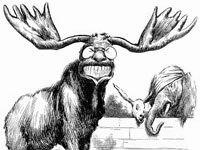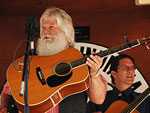Smithsonian American Art Museum: "Inventing a Better Mousetrap"
Have you ever introduced your students to "mystery" objects from the past and asked them to decide what they might be? Watch Suzannah Niepold of the Smithsonian American Art Museum guide TAH teachers in questioning patent models.
Suzannah Niepold: This is a very small exhibition called Inventing a Better Mousetrap, and it’s all about patent models of the type that would have been displayed here when this was the Patent Office Building. There is one case of “mystery patents,” where you’re just given one clue and you’re asked to figure out what you think the thing made. I want to start by breaking up into groups and having you try and guess. The goal of this is for you to be sort of conscience of your process—when you’re faced with an object, what do you look for? How do you try to reason out the purpose? And remember these are models, so the real thing could be much, much bigger, but does not have to be. [Visitors commence group discussions] [Group 1:] Speaker 1: Patent 1368. Speaker 2: It’s got little doors on it. It looks like a submarine almost. Speaker 1: Are there numbers on the windows on the other side? Speaker 2: Yeah, those are for the—I think those are for the schematic though, they’re not for the— Speaker 1: This correlates to that. Speaker 2: Cause there’s an eight on this door—Look at this door. And the portholes are clear. The copper bands to keep the pressure, but I’m worried I’m kind of locked into this submarine thing. I don’t know why I think it’s underwater, I don’t know what the invention might be. Speaker 1: 1858, so we’ve got— Speaker 2: Brooklyn. Speaker 1: St. Louis. Speaker 2: Well, the clue doesn’t help because I was thinking this was maybe the submersible to dig the pylons for the bridge. But what would "mayday" be? It has the top door, and then it has that. Speaker 1: Right, an extra door. And there’s nothing inside except little bits of wood. Speaker 2: Is it like a flare or something? Maybe it is just that size in the "mayday"? Like a signal flare? [Group 2:] Suzannah Niepold: Just try and figure out what it is. Speaker 1: You see that wire? Speaker 2: Yeah, that's right, I was thinking it had something to do with that wire at the end. So those spools come in and it twists them. It’s an automatic fence builder; you’ve got the posts so it’s like— Speaker 1: Yeah, 'cause there’s the fence post— Speaker 2: And that you put the fence post in you see where that little hook is? You put the fence post in the slot, push it, and then the wire comes— Speaker 1: Oh, there you go, you see the little fence post receiver? [Group 3:] Speaker 1: Like a submarine cap, the helmets. Speaker 2: Incense or something like that? Potpourri? Speaker 3: Because, whatever that is…I know you all have talked about this, there’s a little lever. Speaker 4: Oh, I didn’t even see the lever. Speaker 2: That’s the ash maybe? Speaker 3: Yeah, or something. Speaker 4: That’s for a high or a low setting. Speaker 3: Oh, okay. Speaker 2: To let oxygen in or something. Speaker 3: The top thing looks like a lid. Do you think it was something that they would use to eat, or something to produce a smell? Speaker 4: It could be like potpourri? Speaker 1: I’m just thinking, like, to keep your food warm. Speaker 4: It’s functional. Like a food warmer. Speaker 1: Like, I don't know what it's called, it's not a crockpot. I can't remember what it’s called, but you put your food in it, you put your flame at the bottom and then it keeps the heat going. Speaker 4: The first microwave. Speaker 2: A chafing dish, is that what you’re thinking? Speaker 1: Chafing dish, thank you! Speaker 4: I have never heard of that before, I have no idea. Speaker 3: What material do you think it is? What do you think it’s made out of? Speaker 4: It looks like wood. Speaker 3: So if it’s made out of wood it's flammable. Is it wood? Or is it cast iron? The whole thing is iron. Speaker 1: Steel? Speaker 3: If it’s wood it’s going to burn. But I don’t think it's cast iron, I think it’s wood.
Suzannah Niepold: As I said, some of them are more difficult to figure out than others so the goal here was not necessarily for you all to get a right answer. But I’m curious what kinds of things, what kinds of questions did you ask yourself? What kind of information did you need to look for?
Speaker 1: Materials, what’s it made out of?
Speaker 2: Do you recognize any of the parts?
Suzannah Niepold: How else did you try and think things through?
Speaker 3: If it’s very ornate, it was made for people who had income to buy it. So some of these, like this one, it’s very decorated, painted.
Suzannah Niepold: So you meant audience as well, who was this made for? How about, can we go model by model? Group Number 1, what did you think your piece was?
Speaker 4: It’s a burglary system; it’s going to shoot bad guys if they open the door. You open the door, the gun shoots.
Suzannah Niepold: So with this one, you open the door, and the gun shoots. That is a yes. “Theft prevention device. When a thief or intruder entered from the other side of the door, the weighted chain attached to the door released the cocked hammer of the loaded pistol which discharged at the intruder.” The next one, I think, is one of the more challenging ones, 1888. Does anyone have any idea?
Speaker 5: We did it, right? Isn't that Number 2? It’s a fence builder.
Speaker 6: How could you tell?
Speaker 5: We thought it was a barbwire machine maker, because we saw the wire getting twisted, and then you see the wire is getting twisted around pieces of wood. And then you can just sort of see that it used that big hook to push the boards through after they get slid into the wire.
Suzannah Niepold: Yeah, you see the fence essentially coming out this end of the machine. Okay, that’s absolutely what it is. “This contraption automatically twisted the wires around the fence posts that were fed by hand into the machine. This is one of the few models that showed the finished product emerging from the machine.” So of course the real thing in this case would be a lot bigger. Number 3 is a bit of a trick question one. What did we think Number 3 was?
Speaker 7: We thought it was just like a mobile cotton gin. The fact that you say it’s a trick question—we didn’t get it.
Suzannah Niepold: Everyone is so familiar with the cotton gin that as soon as you see cotton, you go right to that. It certainly has to do with cotton, but it’s a cotton seed planter, rather than a cotton harvester that pulls the—it says, “The seeds were poured into the top of the planter; the pins on the rotating shaft prevented the seeds from clogging, while funneling them downward as the farmer pushed the planter along a plowed furrow.” Model Number 4, is the one someone pointed out as maybe made for a wealthier audience—less utilitarian, more attractive. Any idea what it was?
Speaker 8: We’re guessing a bad version of a crockpot? It has the little lever at the bottom so you can adjust what the flame is going to be and how hot it will keep your food. It has the opening at the top for the steam to come out. Or it could be for potpourri.
Speaker 9: It says “smell,” doesn’t it?
Speaker 8: So we were thinking like yummy food—
Suzannah Niepold: How’d you figure out the flame part? The bit at the bottom you connected to a flame—
Speaker 8: Are we right?
Suzannah Niepold: A little bit, not on the crockpot part, but on the flame bit.
Speaker 9: Is it an incense burner?
Suzannah Niepold: It is an incense burner. “A small oil burner inside the base ignited a fuse that was connected to a metal container under the removable cover of the urn. Powdered incense placed in the container then burned, emitting a pleasing odor through the openings in the cover.” Okay, Number 5 was the most challenging. What was your thought process? How did you try and tackle this?
Speaker 10: We started this by trying to figure out the shape and what it was made out of—and from there we just got lost and started talking about submarines and submersibles.
Suzannah Niepold: What led you from the shape of the materials to the idea of a submersible?
Speaker 11: The portholes, the metal bands around it. I think we got kind of sidetracked with this idea of pressure, it’s got a door. And then there’s this red herring, it was invented in Brooklyn. I got totally focused on this idea that it might have been a submersible to dig the support pylons for the Brooklyn Bridge. Then at the very end we were like maybe it’s actually this size? The clue was “mayday,” so I had zero idea. It has an opening hatch, as I was pointing out, but it also has a door on one side, the portholes are—
Suzannah Niepold: Scale is a huge challenge, right? As long as models have to be scaled for display, but it could be any size. So the answer is it’s a life-preserving container. “After the occupants,” so occupants plural, “entered the container through the door at one end it automatically detached from its fastenings on the deck as the ship sank. The floating container was fitted with three bunks for sleeping, compartments for water and provisions, and a sliding hatch cover on top that could be opened for light and air.”
So this was meant to be an example of object-based learning. How do you take an object when you have no idea what it is and kind of logic through what you’re doing. The process is a little bit different with art, as you may have seen. But you’re still sort of taking an object you don’t necessarily know the background information on and getting as much out of it as you can just by looking.


